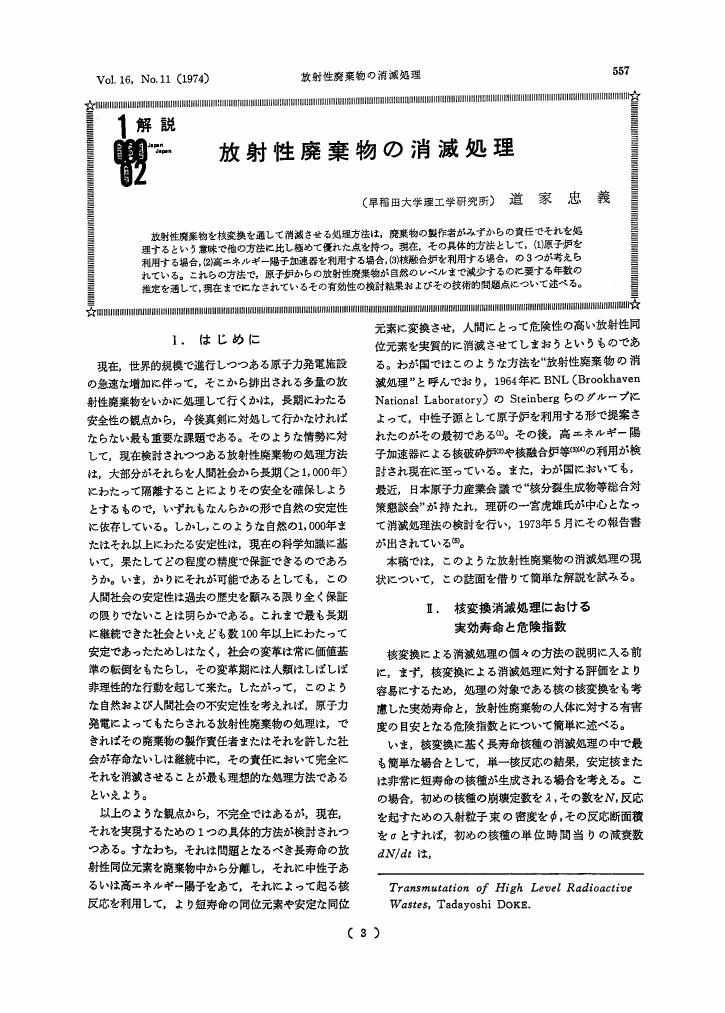1 0 0 0 めでたさの構造--「養老」の世界 (謡曲の思想<特集>)
- 著者
- 菅野 也寸志
- 出版者
- ペリかん社
- 雑誌
- 季刊日本思想史 (ISSN:03853195)
- 巻号頁・発行日
- no.24, pp.p3-16, 1984-10
- 著者
- 松本 隆信 塩見 哲郎 中谷内 一也
- 出版者
- 日本社会心理学会
- 雑誌
- 社会心理学研究 (ISSN:09161503)
- 巻号頁・発行日
- vol.20, no.3, pp.201-207, 2005
- 被引用文献数
- 2
Risk communication is defined as a reciprocal information process between experts and the public concerning some type of risk. Previous studies have not adequately addressed the evaluation of risk communication made by the information source and experts of risk management organizations. The present study examined the evaluations of communication dealing with the risk of nuclear power generation by of public relations officers at a power company. The results showed that messages which elaborated on not only the benefits, but also risk involved in nuclear power, were evaluated as being more fair, honest and self-assuring than those which described only the benefits. Furthermore, two-sided messages were expected to elicit sympathy and trust from the receiver of the messages. These results demonstrated empirically that information sources regard the risk communication as being necessary and useful.
1 0 0 0 OA 1.テネイシン遺伝子欠失マウスにおける行動異常と神経伝達
- 著者
- 吉木 淳 俣賀 宣子 深間内 文彦 日下部 守昭
- 出版者
- 公益社団法人 日本実験動物学会
- 雑誌
- 日本疾患モデル学会記録 (ISSN:09188991)
- 巻号頁・発行日
- vol.11, pp.54-54, 1995-08-15 (Released:2010-08-25)
- 参考文献数
- 2
1 0 0 0 師への恩返し(若手のページ)
- 著者
- 荒川 賢治
- 出版者
- 公益社団法人日本生物工学会
- 雑誌
- 生物工学会誌 : seibutsu-kogaku kaishi (ISSN:09193758)
- 巻号頁・発行日
- vol.83, no.11, 2005-11-25
1 0 0 0 OA Fremy's Salt による酸化
- 著者
- 石井 永
- 出版者
- 社団法人 有機合成化学協会
- 雑誌
- 有機合成化学協会誌 (ISSN:00379980)
- 巻号頁・発行日
- vol.30, no.11, pp.922-941, 1972-11-01 (Released:2010-01-22)
- 参考文献数
- 81
- 被引用文献数
- 5 6
1 0 0 0 OA 放射性廃棄物の消滅処理
- 著者
- 道家 忠義
- 出版者
- 一般社団法人 日本原子力学会
- 雑誌
- 日本原子力学会誌 (ISSN:00047120)
- 巻号頁・発行日
- vol.16, no.11, pp.557-565, 1974-11-30 (Released:2009-04-21)
- 参考文献数
- 12
1 0 0 0 IFRS通信(36)完成版IFRS第9号(11)
- 著者
- 山中 栄子
- 出版者
- 金融財政事情研究会 ; [1950]-
- 雑誌
- 金融財政事情 (ISSN:13453033)
- 巻号頁・発行日
- vol.65, no.43, 2014-11-17
- 著者
- 佐々木 成二 山本 昭一 島崎 健二
- 出版者
- 北海道大學水産學部
- 雑誌
- 北海道大学水産学部研究彙報 (ISSN:00183458)
- 巻号頁・発行日
- vol.32, no.3, pp.p225-233, 1981-09
- 著者
- 佐々木 成二 山本 昭一 島崎 健二
- 出版者
- 北海道大學水産學部
- 雑誌
- 北海道大学水産学部研究彙報 (ISSN:00183458)
- 巻号頁・発行日
- vol.32, no.3, pp.p225-233, 1981-09
1 0 0 0 James Baldwin
- 著者
- edited and with an introduction by Harold Bloom
- 出版者
- Chelsea House
- 巻号頁・発行日
- 2007
1 0 0 0 OA 公立小学校の課外活動における非専門家によるプログラミング教育
- 著者
- 原田 康徳 勝沼 奈緒実 久野 靖
- 雑誌
- 情報処理学会論文誌 (ISSN:18827764)
- 巻号頁・発行日
- vol.55, no.8, pp.1765-1777, 2014-08-15
近年,コンピュータプログラミングが小学校教育においても重要な教育テーマと見なされるようになりつつある.わが国においても,小学生を対象とした多くのプログラミング教育活動があるが,その大半は専門家が教え,多数のヘルパーがつくものであり,そのまま公立小学校などに導入することは難しい.本稿では東京都墨田区立緑小学校の課外活動である「みどりっ子クラブ」において,教育用プログラミング言語「ビスケット」を使用したプログラミング教育の事例について報告している.この活動は,1人ないし2人の非専門家の地域ボランティアによって,各回数名~数十名の児童を集めて3年半にわたり実施されているが,本稿で報告する教え方に関する多様な工夫やそれをサポートするビスケットシステムの工夫のおかげで,うまく機能している.評価として,参加児童の数名に対してインタビューを実施した結果,(1)子どもたちはコンピュータをブラックボックスではなくそのうえで自力で面白いものが作れるようなものだと認識するようになったこと,(2)プログラミング上のさまざまな「技」を進んで教え合っており,協同学習がうまく行われていることが示された.
- 著者
- 南 雅代 Minami Masayo 中村 俊夫 Nakamura Toshio 平田 和明 Hirata Kazuaki 長岡 朋人 Nagaoka Tomohito 鵜澤 和宏 Hoshino Keigo
- 出版者
- 名古屋大学年代測定資料研究センター
- 雑誌
- 名古屋大学加速器質量分析計業績報告書
- 巻号頁・発行日
- vol.18, pp.134-143, 2007-03 (Released:2010-06-10)
During the past several decades, many medieval skeletons were excavated from archaeological sites in the Yuigahama area, Kamakura, Japan. The excavations yielded more than 5,000 individuals in varying states of preservation from the Zaimokuza, Seiyokan, Yuigahama-minami and Chusei Shudan Bochi sites. Medieval Kamakura was an ancient capital of the Kamakura Shogunate, and a lot of people lived in Kamakura with high population density. The human skeletons excavated from the Zaimokuza site are reported to be humans dead by competition at the end of the Kamakura Shogunate, but a detailed study on dating of the human skeletons has not made yet. In this study, we measured ^<14>C ages, together with carbon and nitrogen isotope ratios, of human skeletal remains excavated from the Yuigahama-minami site and Chusei Shudan Bochi site. The δ^<13>C and δ^<15>N were not different between human skeletal samples of both sites, while the ^<14>C ages were different between them: The human bones of the Yuigahama-minami site are 100 year younger than those of the medieval collective-cemetery site. All of ages of human skeletons from both of the sites are older than the latest Kamakura period. The δ^<13>C and δ^<15>N values of the medieval Kamakura people are higher than those of terrestrial mammals, indicating that they exploited some amount of marine fish and/or mammals with higher δ^<13>C and δ^<15>N as protein sources. Therefore, the ^<14>C ages obtained for human skeletons could be order than the true ages. ^<87>Sr/^<86>Sr isotopic ratios of human skeletons of the Yuigahama-minami site tend to be higher than those of the Chusei Shudan Bochi site. Soils, plants and animals feeding on them in a given locality have ^<87>Sr/^<86>Sr values that generally mirror underlying bedrock composition, and thus ^<87>Sr/^<86>Sr ratios of human skeletons are useful tools for assessing migration in prehistory. The result obtained in this study suggests that Yuigahama-minami humans and Chusei Shudan Bochi humas lived in different areas. More skeleton samples should be analyzed for determining detailed ^<14>C ages of humans excavated from the Yuigahama sites, and for estimating migration of prehistory of the medieval Kamakura humans.
1 0 0 0 映画音楽の製作と録音
- 著者
- 浜田 純伸
- 出版者
- The Institute of Noise Control Engineering of Japan
- 雑誌
- 騒音制御 (ISSN:03868761)
- 巻号頁・発行日
- vol.31, no.3, pp.192-197, 2007
- 著者
- 北折 一 板橋 千晶
- 出版者
- カザン月刊「食生活」編集部
- 雑誌
- 食生活 (ISSN:0386989X)
- 巻号頁・発行日
- vol.104, no.2, pp.68-73, 2010-02
1 0 0 0 OA 野菜人工促成栽培新法
- 著者
- 日野 喜文 宮原 泰之
- 出版者
- 神戸大学
- 雑誌
- 國民經濟雜誌 (ISSN:03873129)
- 巻号頁・発行日
- vol.209, no.3, pp.73-87, 2014-03





